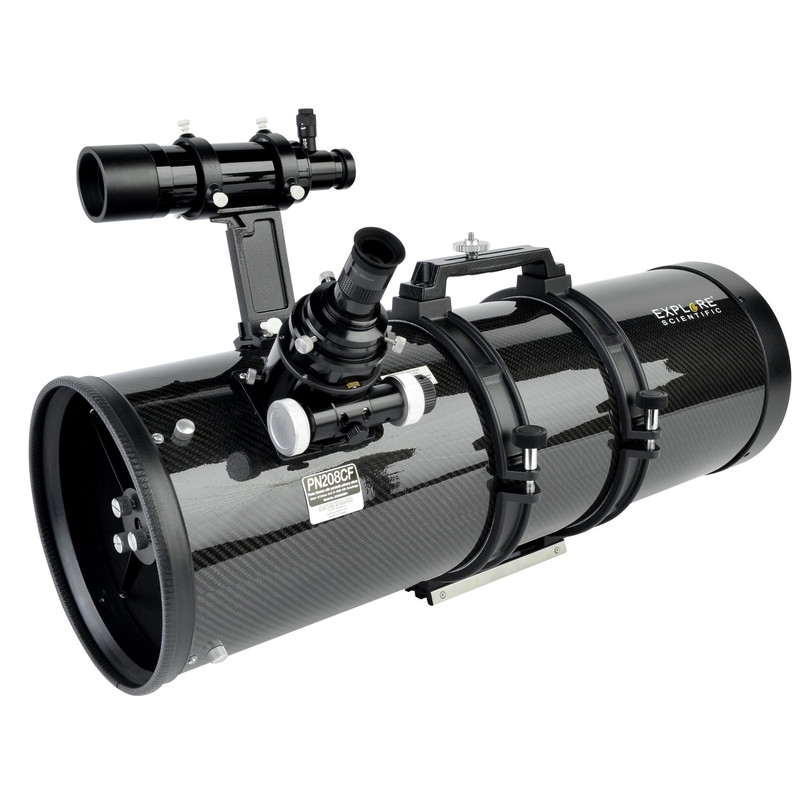Explore Scientific PN208/812 Mark II OTA black
Parabolic Newtonian reflector
| Product ID | 70857 |
| Brand | Explore Scientific |
| Warranty | 2 years |
| EAN | 0753215774166 |
| Shipping Weight | 12.8 kg |
| Optical design | reflector |
In the past few years the Explore Scientific Photo Newtons have become the standard workhorse for Deep Sky astrophotography. We now proudly present the second generation of this telescope, the Explore Scientific Photo Newton Mark II Hexafoc. The Explore Scientific Photo Newton Mark II will deliver you deeper images due to its – compared to competing 8" f/4 systems – oversized primary mirror and therefore faster optical system with the same exposure time. The big 85mm secondary prevents vignetting for optimal illumination The excellent 2.5" Hexafoc also does not cause vignetting due to its large diameter and makes focussing a joy – the smoothness and shifting-free operation sets new standards in this price class. This groundbreaking focuser, tube rings with 44mm universal standard dovetail and camera mounting feature and a high-end finderscope with illumination and laser-engraved scale leave nothing to desire even for demanding astrophotographers. The PN208 Mark II Hexafoc has a classical tube construction with an aluminium tube. The focuser can be upgraded with a 10:1 reduction without problems.
Features:
- Aperture: 208mm; focal length: 812mm
- Excellent 2,5" Hexafoc Focuser
- Ready for the HR Coma Corrector
- Large 85mm secondary and 2.5" focuser offers a perfect field illumination
- 2,5" Hexafoc focuser with possibility to upgrade to a 10:1 reduction
- Universal 44mm Dovetail plate with stainless steel rail (fits LXD75/Great Polaris/EQ5)
- Elaborate 6 point flotation system for mirror support
The kit includes:
- Aluminium tube with optics
- Tube rings with handle and camera mounting feature
- 8x50 Finderscope with illuminated recticle and true oriented view
- 26mmm Super Plössl
- Carrier bag
- Manual
| Product ID | 70857 |
| Brand | Explore Scientific |
| Warranty | 2 years |
| EAN | 0753215774166 |
| Shipping Weight | 12.8 kg |
| Optical design | reflector |
| Optical scheme | Newtonian |
| Primary mirror diameter (aperture), mm | 208 |
| Secondary mirror diameter, mm | 85 |
| Lens (mirror) shape | parabolic |
| Focal length, mm | 812 |
| Magnification, x | 20 — 400 |
| Aperture ratio | f/3.9 |
| Resolution threshold, arcseconds | 0.74 |
| Limiting stellar magnitude | 13.5 |
| Eyepieces | SUPER Plössl 26mm |
| Finderscope | 8x50 |
| Focuser | 2.5" Hexafoc |
| Optical tube material | steel |
| Optical tube weight, kg | 9.8 |
| User level | experienced users, professionals |
| Observed object | planets of the Solar System and deep-sky objects |
| Pouch/case/bag in set | bag |
and downloads
Convenient diagrams that describe how to install additional accessories on refractors and catadioptric telescopes
Find out how to assemble a telescope on an example of the Levenhuk Skyline 90x900 EQ telescope
This short guide will help you avoid typical mistakes and learn more about telescope and mounting types
The basics of astronomical observations for beginners
In this article we have gathered answers to some of the most frequently asked questions about telescopes
How telescopes work?
You can actually perform observations from your balcony!
All about telescope sizes, types, magnification, and mounts
Learn how to set up and use the telescope properly
Astronomy in light-polluted skies. Find out what you can observe in the city
Read an interesting comprehensive article on telescopes for little astronomers
Celestial objects you can observe with telescopes of different apertures
Colored and vivid images of galaxies, planets and star clusters entrance everyone who is fascinated by boundless space
Find an interesting review on the history of the changes to a refracting telescope
To make the process of choosing a telescope easier, we will tell you about the characteristics of the most popular types of telescopes today
Learn everything you need to know about refractor telescopes to make the right choice






